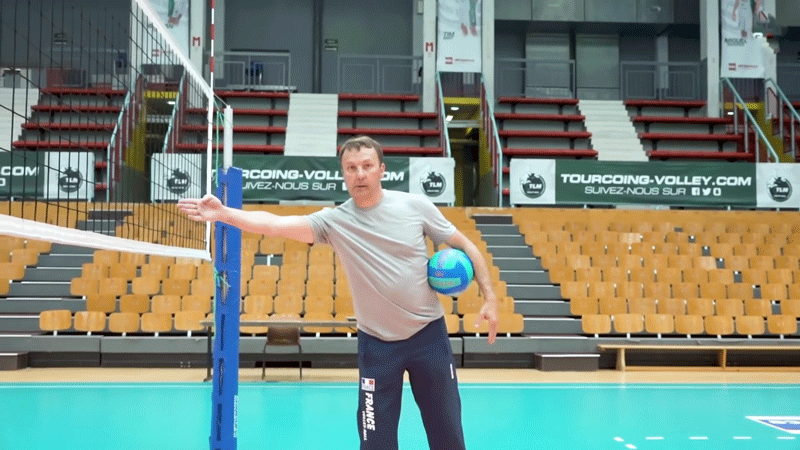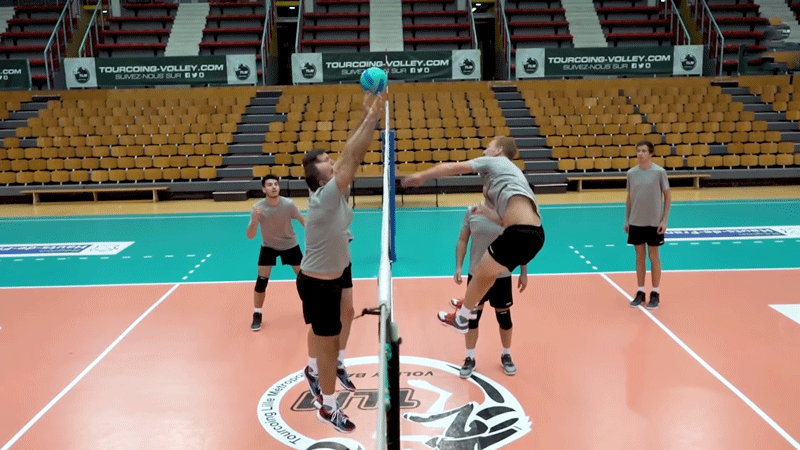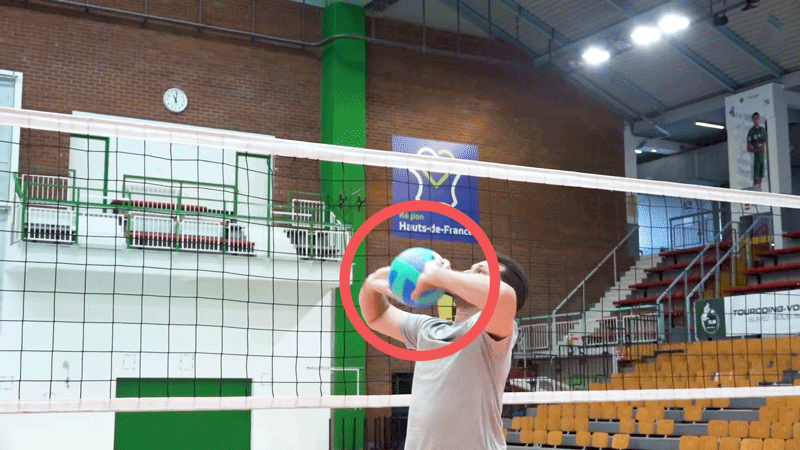What Is A Good Hitting Percentage In Volleyball?
When engaging in higher-level volleyball, monitoring player statistics becomes a crucial aspect of the game.
Hitting percentage, also known as hitting efficiency or kill efficiency, stands out as one of the most valuable metrics for coaches to assess the effectiveness of an attacker.
The assessment of a good hitting percentage varies according to the player’s position and the level of play. As a general guideline, a hitting percentage ranging from .250 to .300 and beyond is considered quite commendable.
Before delving into the specifics, it’s essential to understand how this statistic is calculated and how it differs from similar metrics.
In the subsequent discussion, we’ll explore hitting percentage benchmarks tailored to different positions across various levels of the game. Additionally, we’ll offer insights into strategies for improving your hitting efficiency.
How To Calculate Hitting Percentage In Volleyball?

When delving into the realm of hitting percentage, technically, we are delving into what is known as hitting efficiency.
However, various terms are often employed by individuals to articulate analogous concepts.
Multiple Terms Mean The Same Thing
In discussions surrounding this volleyball statistic, three terms—hitting percentage, hitting efficiency, or kill efficiency—are interchangeably used to refer to the same concept.
Hence, if you encounter any of these terms, understand that they all denote the identical metric.
Despite the interchangeable usage, for simplicity, we will predominantly use the term hitting percentage in our references.
Volleyball Hitting Percentage Formula
Hitting Percentage = (No. Kills – No. Errors)/Total Attempts
Derived from various sources, these numbers contribute to the calculation of hitting percentage.
Begin By Recording Stats
To ascertain hitting percentage, a coach must meticulously record a player’s kills, errors, and attempts. Each kill a player executes is documented on the stat sheet as a ‘+’.
Conversely, every error committed by the player is marked with a ‘-’ on the stat sheet. This thorough tracking system ensures a comprehensive analysis of the player’s performance.
When a player makes an attempt that neither results in a kill nor an error, signifying a continuation of the rally, it is logged as a ‘0’ on the stat sheet. This meticulous recording method captures every nuance of the player’s involvement during the game.
It’s crucial to note that a kill, in this context, refers to an unreturnable hit leading to a point win. This distinction emphasizes the significance of successful attacks in contributing to a team’s success.
Tracking A Player’s Hitting Efficiency
Suppose our star outside hitter, we want to track their hitting efficiency…
Throughout a set, the coaching staff might log something resembling the following.
++-+–0+00+-++0+++00
From this, we can derive the total kills by counting all the plus symbols, which is 10.
The total number of errors made was only 4.
Additionally, there were 6 zero plays, giving us a total of 10+4+6 = 20 attempts.
Use The Volleyball Hitting Percentage Calculator
Now, plugging these numbers into the volleyball hitting percentage calculator provides us with our hitting percentage.
Our outside hitter has a hitting percentage of 0.300. As expressed verbally, a hitting percentage of 0.300 is referred to as a ‘three hundred’.
Alternatively, some people characterize this as ‘30% hitting efficiency’.
Shortly, I’ll explain what this numerical value signifies and whether it can be considered a good hitting percentage or not.
Hitting Percentage Vs Kill Percentage
This is the point where terminology can get a bit tricky, and confusion may arise.
Kill percentage is distinct from kill efficiency, hitting efficiency, or hitting percentage.
Put simply, the kill percentage is calculated as the number of kills divided by the total attempts.
In the given example, our outside hitter made 10 kills out of 20 attempts, resulting in a 50% kill percentage.
It’s evident how these statistics differ slightly, as she has a hitting percentage of .300 but a 50% kill percentage.
Why Does Hitting Percentage Matter?
Hitting percentage, unlike kill percentage, is a more intricate calculation, offering a nuanced insight into a player’s spiking proficiency. It provides a more comprehensive understanding of how effectively a player executes successful attacks, adding depth to the assessment of their overall performance.
The Problem With Kill Percentage
Recall our outside hitter with the 50% kill percentage, achieving 10 kills from 20 attempts.
However, relying solely on kill percentage for performance tracking leaves crucial gaps in information.
We wouldn’t discern whether she made 10 errors or if the opposing team executed 10 exceptional digs to prolong the point—an important distinction that significantly impacts the evaluation of her play.
Hitting Percentage Reveals True Offensive Efficiency
In considering our star player’s performance, if each of the 10 attempts without a kill resulted in a stuff block, her efficiency would markedly decrease compared to a scenario where she skillfully guided the ball over the net to salvage a challenging situation.
By incorporating the variable of errors into our evaluation, we attain a much more comprehensive picture of the player’s proficiency in hitting the ball, capturing the nuances of their strategic decision-making and adaptability on the court.
What Is A Good Hitting Percentage In Volleyball?
In comprehending hitting percentage, the primary factor to acknowledge is the substantial influence of player position.
Different Positions Will Have Different Hitting Percentages

Outside hitters, opposites, and middle blockers each possess distinct benchmarks for hitting percentages.
Middle Blocker Hitting Percentage
Typically, a middle blocker tends to have the highest hitting percentage on a team, primarily because they receive the ball for a set only when there is a well-executed pass from the backcourt.
Regarding middle blockers, a hitting percentage of .350 or higher is regarded as quite good, with anything surpassing 0.400 considered excellent.
Another contributing factor to their high efficiency is that middle blockers typically don’t execute numerous back-row attacks, a task known for its increased difficulty in securing successful kills.
Outside Hitting Percentage
Outsiders frequently find themselves in situations where they must spike stray balls, often far from their ideal hitting window, making it nearly impossible for them to secure a kill.
A considered good hitting percentage for an outside hitter ranges between .250 and .300, with anything exceeding 0.300 being deemed excellent.
Additionally, they commonly face the challenge of being matched up against a formidable opposite blocker, adding to the difficulty of their performance at the net.
Opposite Hitting Percentage
Likewise, opposites often contend with numerous scrappy sets, a factor that tends to lower their hitting percentage.
For an opposite hitter, a considered good hitting percentage falls within the range of .270 to .320, and anything surpassing 0.320 is deemed excellent.
Moreover, opposites shoulder a significant responsibility for executing back-row attacks, inherently associated with a lower kill percentage, thereby contributing to a further decrease in their overall hitting efficiency.
What Is An Average Hitting Percentage In Volleyball?
Once again, it’s important to note that these numbers can vary depending on the player’s position. Generally speaking, a hitting percentage falling within the range of .200 to .250 is considered fairly average.
However, for a middle blocker, such figures may indicate a slight underperformance, given their usual benchmarks for hitting efficiency.
Is a Negative Hitting Percentage Possible in Volleyball?
When a hitting percentage consistently falls below .100, it raises significant concerns.
While a player with a .100 hitting percentage technically contributes points for their team, the rate may not be satisfactory.
Furthermore, a negative hitting percentage is plausible, indicating that the player is more prone to making errors than achieving successful kills when hitting the ball.
In the context of spiking, such a player becomes a liability on the court.
Is A Hitting Percentage Of 0 Considered Average?
If your hitting percentage hovers around 0, it indicates that you’re neither contributing positively nor negatively to your team’s point tally.
However, it’s crucial to understand that a hitting percentage of 0 doesn’t equate to an average performance; rather, it signifies underperformance.
In the context of spiking, the expectation is to secure kills. The essence of spiking lies in the opportunity to capitalize on a set ball and conclusively end the rally.
Consequently, when we spike the ball in volleyball, the objective is to consistently win points, as that is inherent to the dynamics of the game.
Volleyball Hitting Percentage Targets
To be considered strong offensively, you and your team should aim for the following figures:
| Position | Hitting Percentage |
|---|---|
| Middle Blocker | .350 |
| Outside Hitter | .250-300 |
| Opposite Hitter | .270-320 |
| Team | .300 |
It’s important to note that falling short of these numbers doesn’t necessarily imply underperformance. However, there should still be a concerted effort to strive towards reaching these benchmarks.
How Do You Enhancing Your Volleyball Hitting Percentage?
Increasing your hitting percentage in volleyball boils down to two fundamental approaches: either augmenting the number of kills you achieve or minimizing hitting errors.
It’s worth noting, as a somewhat tongue-in-cheek alternative, that changing your position to middle blocker could be considered a “cheat code” for improving hitting efficiency.
Get More Kills
I recently compiled a list of 10 things you can do to enhance your performance and secure more kills in volleyball, so I would recommend beginning your efforts there.
Make Less Hitting Errors
This might sound somewhat broad, but in essence, it boils down to just three fundamental aspects.
1. You’re hitting the ball into the net too much…

Due to various reasons, this issue can arise.
Are you attempting to hit the ball excessively hard? Are you striving for exceptionally sharp angles to impress your teammates?
Perhaps you’re still in the learning phase, or maybe you’re shorter and less experienced.
To address this, concentrate on making contact with the ball at a higher point.
Instead of forcefully hitting the ball when it’s not in an optimal position, focus on refining your ability to tool the ball off the block or aim for the back of the court through deliberate practice.
2. hitting the ball out of bounds too much…
At least you’re successfully getting the ball over the net!
If you find yourself frequently hitting the ball wide, likely, you’re likely still attempting angles that are too sharp. You might benefit more by redirecting your aim towards the corners of the backcourt.
3. You’re getting blocked too often…
Several factors could contribute to this situation. It might indicate that you’re facing an exceptionally skilled defensive team.
However, it’s also plausible that you need to be more strategic in the placement of your shots.
Consider taking some power off the ball and concentrating on targeting open areas of the court.
While this adjustment may not immediately result in numerous kills, it’s a gradual process of improvement – take it step by step.
Also Read: 16 Expert Volleyball Outside Hitter Tips
